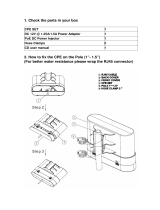
II
4.8 Wireless settings....................................................................................................................35
4.9 Forwarding .............................................................................................................................36
4.9.1 Virtual Servers................................................................................................................37
4.9.2 Port Triggering................................................................................................................38
4.9.3 DMZ................................................................................................................................40
4.9.4 UPnP ..............................................................................................................................41
4.10 Security ..................................................................................................................................41
4.10.1 Firewall ...........................................................................................................................42
4.10.2 IP Address Filtering........................................................................................................43
4.10.3 Domain Filtering .............................................................................................................44
4.10.4 MAC Address Filtering ...................................................................................................46
4.10.5 Remote Management.....................................................................................................47
4.10.6 Advanced Security .........................................................................................................48
4.11 Static Routing.........................................................................................................................50
4.12 IP & MAC Binding ..................................................................................................................51
4.12.1 Binding Setting ...............................................................................................................51
4.12.2 ARP List..........................................................................................................................52
4.13 Dynamic DNS ........................................................................................................................53
4.13.1 Dyndns.org DDNS..........................................................................................................53
4.13.2 Oray.net DDNS ..............................................................................................................54
4.13.3 Comexe.cn DDNS..........................................................................................................55
4.14 SNMP.....................................................................................................................................56
4.14.1 Community Setting .........................................................................................................56
4.14.2 SNMP System Setting....................................................................................................57
4.15 System Tools .........................................................................................................................58
4.15.1 Time................................................................................................................................58
4.15.2 Firmware.........................................................................................................................59
4.15.3 Factory Defaults .............................................................................................................60
4.15.4 Backup & Restore ..........................................................................................................61
4.15.5 Ping Watch Dog .............................................................................................................61
4.15.6 Speed Test .....................................................................................................................62
4.15.7 Reboot............................................................................................................................63
4.15.8 Password........................................................................................................................64
4.15.9 Syslog.............................................................................................................................64
4.15.10 Statistics .....................................................................................................................65
Chapter 5 AP Operation Mode......................................................................................................67
5.1 Login ......................................................................................................................................67
5.2 Status.....................................................................................................................................67





















